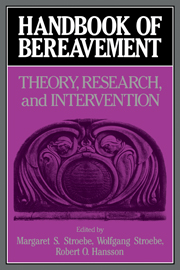Book contents
- Frontmatter
- Contents
- Contributors
- Preface
- Part I Introduction
- Part II The phenomenology and measurement of grief
- Part III Current theories of grief, mourning, and bereavement
- Part IV Physiological changes following bereavement
- Part V The psychological, social, and health impacts of conjugal bereavement
- 12 The mortality of bereavement: A review
- 13 Psychological resilience among widowed men and women: A 10-year follow-up of a national sample
- 14 Determinants of adjustment to bereavement in younger widows and widowers
- 15 The impact of spousal bereavement on older widows and widowers
- 16 The course of spousal bereavement in later life
- 17 Risk factors in bereavement outcome
- Part VI Grief reactions to different types of loss
- Part VII Coping, counseling, and therapy
- Part VIII Conclusions
- References
- Author index
- Subject Index
17 - Risk factors in bereavement outcome
Published online by Cambridge University Press: 04 May 2010
- Frontmatter
- Contents
- Contributors
- Preface
- Part I Introduction
- Part II The phenomenology and measurement of grief
- Part III Current theories of grief, mourning, and bereavement
- Part IV Physiological changes following bereavement
- Part V The psychological, social, and health impacts of conjugal bereavement
- 12 The mortality of bereavement: A review
- 13 Psychological resilience among widowed men and women: A 10-year follow-up of a national sample
- 14 Determinants of adjustment to bereavement in younger widows and widowers
- 15 The impact of spousal bereavement on older widows and widowers
- 16 The course of spousal bereavement in later life
- 17 Risk factors in bereavement outcome
- Part VI Grief reactions to different types of loss
- Part VII Coping, counseling, and therapy
- Part VIII Conclusions
- References
- Author index
- Subject Index
Summary
It has been estimated that a third of all major bereavements result in problems where professional help may be required (Raphael, 1983). For example, conjugal bereavement, when there is intense loneliness, appears to increase health risk, often resulting in the death of the surviving spouse (M. Stroebe & Stroebe, this volume; Maddison & Viola, 1968; Parkes & Brown, 1972). Similarly, the death of a child is associated with high morbidity in surviving parents (Fish, 1986; Rando, 1983; Sanders, 1986). Other factors, such as sudden death, lack of perceived support, or reduced material resources, have also been implicated as associated with high health risk. This chapter focuses on high-risk factors for poor outcome of bereavement, separating them into four general categories: biographical/demographic factors, individual factors, type and mode of death, and circumstances following the loss. It pays particular attention to the interaction and overlapping of these factors, which can cause greatly increased health risk.
It must be noted from the outset that a variety of methodological concerns cloud the interpretation of available data on bereavement research. For example, generalizability must be questioned when samples are composed of women primarily. Too, because of the private nature of grief in our culture and the inaccessibility of subjects, only those individuals who “volunteer” to participate can be included. This bias in subject selection introduces the possibility that a significant section of the population might evidence differing forms of grief than the ones described in the current literature.
- Type
- Chapter
- Information
- Handbook of BereavementTheory, Research, and Intervention, pp. 255 - 268Publisher: Cambridge University PressPrint publication year: 1993
- 64
- Cited by

